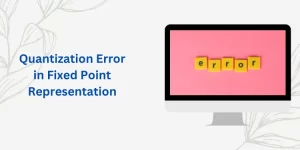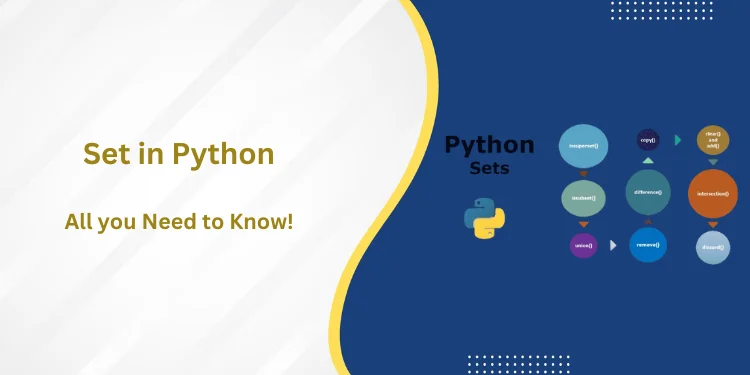Table of Contents
ToggleIntroduction
Fixed point representation is a method of representing numerical values using a fixed number of bits. In this representation, the number of bits allocated to represent the integer and fractional parts of a number are predetermined. The fixed number of bits for each part of the number is referred to as the fixed-point format. This format allows for a greater range of values to be represented compared to floating-point representation, while requiring fewer bits.
The fixed-point format is used in many applications where high accuracy is required and floating-point arithmetic is not practical or efficient. For example, fixed point is used in digital signal processing, image processing, and embedded systems. In these applications, fixed-point arithmetic can be performed faster and with less memory than floating-point arithmetic.
One disadvantage of fixed point is that the precision of the representation is limited by the number of bits allocated to the fractional part of the number. This can lead to rounding errors and loss of precision when performing arithmetic operations on very large or very small numbers.
In summary, fixed point is a useful method for representing numerical values in a wide range of applications where high accuracy is required, and floating-point arithmetic is not practical. While it has some limitations, its efficiency and accuracy make it a valuable tool in many contexts.
Benefits of Fixed Point Representation

Fixed point representation offers several benefits over other methods of numerical representation, particularly in applications where high accuracy is required, and floating-point arithmetic is not practical or efficient. Some of the benefits of fixed point representation are:
Efficiency: Fixed-point arithmetic is typically faster and requires less memory than floating-point arithmetic, making it more efficient in applications where real-time processing is required.
Deterministic behavior: Fixed-point arithmetic has deterministic behavior, which means that the results of arithmetic operations are predictable and consistent.
Range of values: Fixed point representation allows a greater range of values to be represented than other methods of numerical representation, while still requiring fewer bits.
Precision: Fixed-point arithmetic can provide higher precision than other methods of numerical representation, particularly in applications where the number of decimal places required is fixed.
Ease of implementation: Fixed-point arithmetic is relatively easy to implement in software and hardware, making it a popular choice for many embedded systems and digital signal processing applications.
Compatibility with existing hardware: Fixed point is often used in existing hardware, making it a natural choice for applications that require compatibility with legacy systems.
Overall, fixed point representation is a valuable tool in many contexts due to its efficiency, range of values, precision, and ease of implementation. Its deterministic behavior also makes it a popular choice in applications where predictable and consistent results are essential.
Click here to know more about: data analyst course in Mumbai
Types of Fixed Point Representations
 There are several types of fixed point representations used in numerical computing, each with its own characteristics and benefits. Here are some of the most common types:
There are several types of fixed point representations used in numerical computing, each with its own characteristics and benefits. Here are some of the most common types:
Unsigned fixed-point: This representation is used for non-negative integers and has no sign bit. It is useful for applications that require only positive numbers.
Signed fixed-point: This representation includes a sign bit and is used to represent both positive and negative numbers. It is commonly used in arithmetic operations.
Scaled fixed-point: This representation uses a scaling factor to convert a fixed-point number to a floating-point number. The scaling factor is used to adjust the precision of the number, making it useful for applications that require high precision.
Two’s complement fixed-point: This representation is used to represent both positive and negative numbers and is commonly used in digital signal processing applications. It uses the two’s complement method to represent negative numbers.
Q-format fixed-point: This representation is commonly used in signal processing applications and is based on the use of a scaling factor. The scaling factor determines the number of fractional bits in the representation, making it useful for applications that require high precision.
Integer-only fixed-point: This representation is used to represent only integers and has no fractional part. It is useful for applications that do not require high precision.
Each type of fixed point has its own advantages and disadvantages, and the choice of representation depends on the specific application and requirements. The most suitable type of fixed point representation for a particular application is determined by factors such as precision, range of values, memory requirements, and computational efficiency.
Conversion Between Fixed Point and Floating Point
 Fixed-point and floating-point are two different methods of representing numerical values. Fixed-point is a method of representing numbers using a fixed number of bits, while floating-point uses a variable number of bits to represent a number. Conversion between fixed-point and floating-point representation is necessary in many applications, such as signal processing and image processing.
Fixed-point and floating-point are two different methods of representing numerical values. Fixed-point is a method of representing numbers using a fixed number of bits, while floating-point uses a variable number of bits to represent a number. Conversion between fixed-point and floating-point representation is necessary in many applications, such as signal processing and image processing.
To convert a fixed-point number to a floating-point number, the fixed-point number is first divided by a scaling factor that is determined by the number of fractional bits in the fixed point representation. The result is then multiplied by a power of two that corresponds to the position of the most significant bit in the fixed point. This converts the fixed-point number into a floating-point number.
To convert a floating-point number to a fixed-point number, the number is first scaled by a power of two that corresponds to the position of the most significant bit in the desired fixed point representation. The result is then rounded to the nearest integer and represented in the fixed-point format.
It is important to note that conversion between fixed-point and floating-point representations can lead to loss of precision and rounding errors. Careful consideration of the scaling factor and rounding method is necessary to minimize these errors.
In summary, conversion between fixed-point and floating-point representations is necessary in many applications. The process involves scaling and rounding the number to convert it to the desired format. Careful consideration of the scaling factor and rounding method is necessary to minimize errors.
Also read: data science training in Bangalore
Precision and Range of Fixed Point Representation
 The precision and range of fixed point representation depend on the number of bits allocated to represent the integer and fractional parts of a number. In general, increasing the number of bits increases the precision and range of the fixed point representation.
The precision and range of fixed point representation depend on the number of bits allocated to represent the integer and fractional parts of a number. In general, increasing the number of bits increases the precision and range of the fixed point representation.
Precision refers to the number of decimal places that can be represented in a number. In fixed point, precision is determined by the number of fractional bits allocated. For example, a fixed point representation with 16 bits and 8 fractional bits can represent values with a precision of 1/256 or approximately 0.00390625.
Range refers to the maximum and minimum values that can be represented in a number. In fixed point , the range is determined by the number of integer bits allocated. For example, a fixed point representation with 16 bits and 8 integer bits can represent values between -128 and 127.
The precision and range of fixed point are important factors to consider when choosing a numerical representation for a particular application. A higher precision is desirable for applications that require more accurate calculations, while a larger range is necessary for applications that require the representation of large or small values.
It is important to note that increasing the precision and range of fixed point comes at the cost of increased memory requirements and computational complexity. Therefore, choosing the appropriate number of bits for fixed point representation requires careful consideration of the requirements of the specific application.
Arithmetic Operations on Fixed Point Numbers
Arithmetic operations on fixed-point numbers are similar to those on integers, with the added complexity of handling fractional parts. The basic arithmetic operations that can be performed on fixed-point numbers include addition, subtraction, multiplication, and division.
Addition and subtraction of fixed-point numbers are performed by aligning the decimal points and adding or subtracting the integer and fractional parts separately. The result is then rounded to the desired precision.
Multiplication and division of fixed-point numbers require additional steps to handle the fractional parts. To multiply two fixed-point numbers, the integer parts are multiplied using integer multiplication rules, and the fractional parts are added to the result using the distributive property of multiplication. To divide two fixed-point numbers, the dividend is multiplied by a reciprocal of the divisor to convert the division into a multiplication operation.
In addition to basic arithmetic operations, advanced operations such as square root and trigonometric functions can also be performed on fixed-point numbers using specialized algorithms.
When performing arithmetic operations on fixed-point numbers, it is important to consider the precision and range of the numbers to avoid overflow or underflow errors. Careful selection of the number of bits allocated for the integer and fractional parts and the scaling factor can help minimize these errors.
In summary, arithmetic operations on fixed-point numbers are similar to those on integers, but require additional steps to handle the fractional parts. The precision and range of the numbers should be carefully considered to avoid errors.
Quantization Error in Fixed Point Representation
 Quantization error in fixed point representation is the difference between the actual value of a signal and the quantized value that is represented using a limited number of bits. It is an unavoidable error that arises when converting continuous analog signals to digital signals with a finite number of bits.
Quantization error in fixed point representation is the difference between the actual value of a signal and the quantized value that is represented using a limited number of bits. It is an unavoidable error that arises when converting continuous analog signals to digital signals with a finite number of bits.
Quantization error can be minimized by increasing the number of bits used to represent the signal. However, this comes at the cost of increased storage and processing requirements.
The quantization error is proportional to the step size, which is determined by the number of bits allocated for the representation. For example, if a 10-bit fixed point representation is used to represent a signal with a range of 0 to 1, the step size is 1/1024 or approximately 0.00097656. The quantization error for a signal with a value of 0.5 would be half the step size, or approximately 0.00048828.
Quantization error can have a significant impact on the quality of signals, particularly in applications such as audio and video processing. To minimize the impact of quantization error, techniques such as dithering and noise shaping can be used. Dithering involves adding a small amount of noise to the signal to mask the quantization error, while noise shaping involves shaping the quantization noise to minimize its perceptual impact.
In summary, quantization error is an unavoidable error that arises when converting continuous analog signals to digital signals with a finite number of bits. The error is proportional to the step size, which is determined by the number of bits allocated for the representation. Techniques such as dithering and noise shaping can be used to minimize the impact of quantization error.
Fixed Point in Digital Signal Processing
Fixed point representation is widely used in digital signal processing (DSP) due to its computational efficiency and low hardware requirements. DSP applications such as audio and image processing often involve the processing of large amounts of data in real-time, which requires high-speed and low-power processing.
Fixed point representation is used to represent digital signals as binary numbers with a fixed number of integer and fractional bits. The precision and range of the fixed point representation can be optimized for the specific application to balance computational efficiency and accuracy.
In DSP applications, fixed-point arithmetic operations are performed using digital signal processors or field-programmable gate arrays (FPGAs). These devices are optimized for fixed-point arithmetic and can perform complex DSP algorithms such as Fourier transforms, digital filters, and signal modulation/demodulation.
One of the challenges in fixed-point DSP is managing the effects of quantization error. This error can accumulate over multiple arithmetic operations and cause significant degradation in the quality of the signal. Techniques such as scaling, saturation, and rounding can be used to manage quantization error and maintain the quality of the signal.
Overall, fixed point representation is a popular choice for digital signal processing due to its computational efficiency, low hardware requirements, and flexibility in optimizing the precision and range of the representation for specific applications.
Implementing Fixed Point Representation in Hardware
Implementing fixed point representation in hardware involves designing circuits that can perform arithmetic operations on fixed-point numbers. The design must take into account the number of bits allocated for the integer and fractional parts, as well as the scaling factor, to ensure that the representation can accommodate the desired range and precision.
The hardware implementation of fixed-point arithmetic operations can be achieved using digital signal processors, FPGAs, or custom-designed application-specific integrated circuits (ASICs). These devices are optimized for fixed-point arithmetic and can perform complex algorithms with high efficiency.
To perform arithmetic operations on fixed-point numbers, the hardware must include circuits for addition, subtraction, multiplication, and division. These circuits must be designed to handle both the integer and fractional parts of the numbers separately. For example, to perform multiplication, the hardware must include circuits for integer multiplication, as well as circuits for multiplying the fractional parts and adding them to the result.
Another important consideration in hardware implementation is managing quantization error. This can be achieved using tech
niques such as rounding, truncation, and saturation. Rounding involves rounding the result to the nearest representable value, while truncation involves discarding the least significant bits. Saturation involves limiting the range of the result to prevent overflow or underflow errors.
In summary, implementing fixed point representation in hardware requires designing circuits that can perform arithmetic operations on fixed-point numbers. The hardware must be optimized for the specific range and precision required by the application and must include circuits for addition, subtraction, multiplication, and division. Techniques for managing quantization error must also be implemented to ensure the accuracy of the results.
Conclusion
In conclusion, fixed point representation is a widely used technique for representing and processing digital signals with limited resources. Its efficient computational performance and low hardware requirements make it a popular choice for applications such as digital signal processing, embedded systems, and communications.
However, the accuracy of fixed point is limited by the number of bits allocated for the representation, which can result in quantization errors that degrade the quality of the signal. To address this, various techniques such as scaling, rounding, and noise shaping can be used to minimize the impact of quantization errors.
In the future, advancements in fixed point are expected to focus on improving the precision and accuracy of fixed-point arithmetic, particularly in applications where high accuracy is critical, such as image and audio processing. New algorithms and techniques that optimize the use of fixed-point arithmetic are also likely to emerge.
Moreover, with the rise of artificial intelligence and machine learning, fixed point representation is expected to play a key role in optimizing the performance of neural networks and deep learning algorithms on resource-limited devices such as mobile phones and IoT devices.
Overall, fixed point representation is a fundamental technique in digital signal processing and is expected to continue to play an important role in various applications, particularly in resource-constrained environments where computational efficiency and low hardware requirements are essential.
Frequently Asked Questions
What is fixed-point representation?
Fixed-point representation is a method of representing numbers with a fixed number of integer and fractional bits. It is commonly used in digital signal processing and other applications where a limited range of values needs to be represented with high accuracy.
How is fixed-point representation different from floating-point representation?
Fixed-point representation uses a fixed number of bits to represent the number, while floating-point representation uses a variable number of bits. This means that fixed-point numbers have a limited range and precision, while floating-point numbers can represent a much wider range of values with higher precision.
How is quantization error managed in fixed-point representation?
Quantization error occurs when a real number is rounded to the nearest representable value in the fixed-point representation. This error can be managed using techniques such as rounding, truncation, and noise shaping.
What is the impact of the number of bits on fixed-point representation?
The number of bits allocated to the integer and fractional parts determines the range and precision of the fixed-point representation. Increasing the number of bits increases the range and precision, but also increases the hardware requirements and computational complexity.
What are the benefits of using fixed-point representation in digital signal processing?
Fixed-point representation is more computationally efficient than floating-point representation, and requires less hardware resources. It is also more flexible in terms of the range and precision that can be achieved, which is important in applications where a specific range and precision are required













